
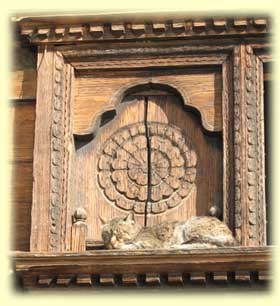
Monday 1st May 2006
Trek Day 8
Thulo Syabru to Lama Hotel
We say goodbye to a friend.
I detach the Velcro tabs on the fly sheet, and I’m treated to a wonderfully clear day. Liz is feeling much better. It’s just gone half past five, and we’ve overslept a little. Having spent so much time in the tent yesterday, I’ve unpacked loads of odds and ends, which are scattered around. It seems to have taken forever to get everything packed again. Before I’ve finished packing, nature calls, and I’m forced to dash off to the toilet tent. I start to wonder whether I’m going down with the same thing as Liz. Fortunately though, all is well!
Nurbu has come up with some alternative plans, just in case Liz is still ill, but as she is on the mend we stick to our original plan to trek a little way up the Langtang valley, to Lama Hotel. Everyone seems relaxed this morning, including Khukri, who jumps down from the upper terrace to say good morning. He’s become part of the gang, and everyone has grown fond of him, despite his barking at strangers. He is very protective of our ‘pack’ and constantly checks that Liz and I are OK; especially Liz.
 We have our breakfast of porridge, spicy parathas, and omelette. Liz has her appetite back, and has been able to eat some breakfast this morning; which is good news. We break camp and set off through the village of Syabru. Confusingly, there are two Syabrus, an upper one, and a lower one. This is Thulo Syabru, or upper Syabru. The other one, where we hope to get the bus back to Kathmandu, is Syabru Bensi. We have our breakfast of porridge, spicy parathas, and omelette. Liz has her appetite back, and has been able to eat some breakfast this morning; which is good news. We break camp and set off through the village of Syabru. Confusingly, there are two Syabrus, an upper one, and a lower one. This is Thulo Syabru, or upper Syabru. The other one, where we hope to get the bus back to Kathmandu, is Syabru Bensi.
The village is strung out along a ridge which slopes down towards the Langtang Khola. The place is extraordinarily photogenic, especially in the low morning sunlight, and I’m still wandering around taking pictures, an hour after leaving the camp. Most of the larger buildings are on the crest of the ridge, and the ones with the best views have been set up as lodges. There is a fantastic choice of accommodation. All the lodges appear to have solar hot showers, and comprehensive menus. Some advertise solar powered lighting in all rooms, and there is even one with the balustrade of its balconies, decorated with stars of David; presumably to appeal to the Israeli trekkers. Some of the older buildings have intricate carvings in the wood around the window frames. The low sunlight helps to bring out the relief in the carvings making them all the more attractive.
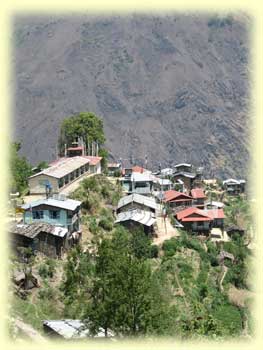 We look across the valley from a gap between the building and can see the kitchen staff and porters making their way through the terraces below, followed closely by Khukri. We decide that it’s time to move on, and start to follow in their footsteps. The day is becoming quite warm, and we start to feel the effect of the strong sun, so we stop and slap on some sun cream. We look across the valley from a gap between the building and can see the kitchen staff and porters making their way through the terraces below, followed closely by Khukri. We decide that it’s time to move on, and start to follow in their footsteps. The day is becoming quite warm, and we start to feel the effect of the strong sun, so we stop and slap on some sun cream.
The traverse across the hillside and through the farms is fun, and full of interest. We see that the farmers have various methods of keeping the birds from eating the seeds. There are all sorts of scarecrows, and bits of paper on sticks blowing in the wind. One guy has a long piece of string tied to some sticks in the field with plastic bags attached. The string leads back to his house, so he can yank the cord every now and then to frighten off the birds. I tell Nurbu about the bird scarers that have become popular in England. These are gas-powered contraptions that let off a controlled gas explosion at regular intervals. Not only do they frighten birds, but they also frighten the hell out of anyone walking past on a footpath. This probably goes someway to explaining their popularity! I’m glad they haven’t reached Syabru yet.
We stop for a rest, and watch some shrike hunting in the vicinity of a small stream running between the terraces. As we walk on, the path climbs, and then contours upstream along the bank of a major tributary of the Langtang Khola. We can see the path on the other side, and eventually reach a new suspension bridge, which takes us across the river. We climb again; this time, downstream towards the main Langtang Khola. We can see back towards Thulo Syabru, resplendent in the morning sun.
Once the trail reaches the main valley, it starts to descend steeply. I watch as my altimeter tells of all the hard-earned altitude that we are losing and of all the climbing that we are going to have to do, to reach Lama Hotel! As we descend, the impressive roar of cascading water, announces the proximity of a powerful glacial torrent, and I’m reminded that so far on this trek, we’ve only been following the ridges. Most of our treks in the past have involved a lot of travelling up and down valleys, close to major rivers. It’s nice to be back by the water, and we soon get used to the noise of the wild raging madness below us.
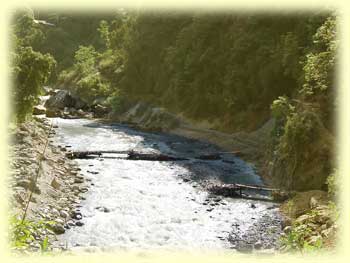 We start to gain height again. The rate at which we are climbing indicates how steeply the Langtang Khola is falling on its journey to join the Trishuli River. The valley at this point is surprisingly narrow. The path, which runs through dense forest which clings precariously to the steep valley sides, is in good condition, but being so close to the water, the air is becoming quite humid, and has me breaking out in a sweat as I climb. Apart from the humidity, I’m really enjoying the walking today. After the steep bits there are usually short stretches of level pathway, which give a chance to recover in time for the next steep bit. We start to gain height again. The rate at which we are climbing indicates how steeply the Langtang Khola is falling on its journey to join the Trishuli River. The valley at this point is surprisingly narrow. The path, which runs through dense forest which clings precariously to the steep valley sides, is in good condition, but being so close to the water, the air is becoming quite humid, and has me breaking out in a sweat as I climb. Apart from the humidity, I’m really enjoying the walking today. After the steep bits there are usually short stretches of level pathway, which give a chance to recover in time for the next steep bit.
We stop for a welcome rest and a drink at a tea-house. This is the aptly named settlement called Landslide. We can see evidence of old, and other more recent landslides, in this area. Some are slight, but others are over a hundred metres wide. The after effects of these must have been devastating.
Nurbu points out some natural bee hives clinging to the overhanging cliffs, on the opposite side of the river. We stop for a while to take some photos. We can clearly see swarms of bees surrounding the hives and what looks like a rope hanging down from above. The hives appear to be inaccessible, but the rope is probably used by honey hunters, who climb down to harvest the honey.
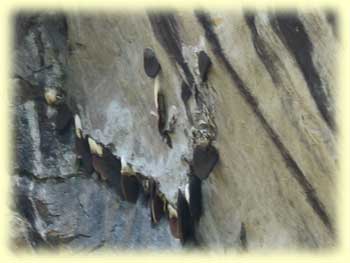 We reach another group of tea-houses at a place called Bamboo, also named for obvious reasons. What with the upcoming Lama Hotel, this is becoming a valley of obviously named settlements. We decide to walk on, and after crossing another landslide area, we meet up with Chotti and the kitchen boys preparing lunch. They’ve set themselves up right by the river where a small pebble beach has formed. It would be a great place to stop if it wasn’t for the insects. This whole section of river is infested with thousands of flies and midges, which buzz around our heads driving us mad. We eat our lunch quickly, and move on to get away from the irritation. It would have been nice to stop for longer, while our perspiration sodden clothes dried, but it was impossible. We reach another group of tea-houses at a place called Bamboo, also named for obvious reasons. What with the upcoming Lama Hotel, this is becoming a valley of obviously named settlements. We decide to walk on, and after crossing another landslide area, we meet up with Chotti and the kitchen boys preparing lunch. They’ve set themselves up right by the river where a small pebble beach has formed. It would be a great place to stop if it wasn’t for the insects. This whole section of river is infested with thousands of flies and midges, which buzz around our heads driving us mad. We eat our lunch quickly, and move on to get away from the irritation. It would have been nice to stop for longer, while our perspiration sodden clothes dried, but it was impossible.
Unusually, Khukri is missing this lunchtime, so we ask if anyone has seen him. Sadly we learn that after being with us for so long, through thick and thin, he was just too scared to cross the bridge that we crossed earlier. Chotti said that the boys tried to carry him across but he just wouldn’t go. They tried everything but he was just too frightened. We really miss him. We rationalise our sense of loss by convincing ourselves that it’s better that he didn’t follow us to the road-head. There we might have been forced to leave him, fighting over scraps of rubbish with all the other scabby dogs. That would have been much worse. As it is, he’ll probably backtrack, and meet up with all the people who fed, and befriended him on the way. Better that, than seeing him chase after the bus when we head back to Kathmandu. In Syabru, Nima had talked about adopting Khukri and taking him back to Kathmandu, and we’d offered to pay to get him vaccinated. Still, I’m sure he’ll be ok. Before long he’ll be hooked up with another group of trekkers. Until they cross a bridge, that is!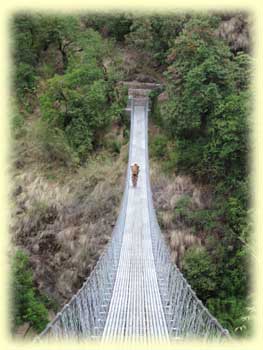
We now cross another suspension bridge over the main river, and continue climbing until we reach Rimche, where we stop for a drink. There’s a small stream here, and I delight in having a wash in the cool clear water. The sky has clouded over, and it looks like it will rain. I suggest to Liz that we’d better move on before we get caught in a downpour, but the lady at the tea-house shakes her head and says ‘No, no rain today’.
Ten minutes further along the trail we are scrabbling through our sacks to locate our waterproof gear, as the heavens open up. It’s still hot and humid, and we’re getting so sweaty that we might just as well have not bothered putting on our ponchos. We stop and shelter under the eaves of a tea-house by the path, hoping that the rain will stop. When it’s becomes obvious that it won’t, we dash on for the last twenty minutes, to our camp at the Tibet Guest House, in the village of Lama Hotel.
The tents have already been set up, in the small yard next to the lodge, and we are invited into the warm dry dining room. More wood is shoved on the fire, and we are soon dry and comfortable. There are two large rooms in the single storey, stone building, separated by a wooden partition. The main room houses the family, who sit on the floor around the cooking stove. Our crew join them, and soon they are all happily chatting away and drinking tea, while we munch away at our cheese and biscuits in the adjoining dining area, which has large windows and is less smoky.
We order a beer as a Dutch couple arrive. After a while we start chatting. This is their first time travelling outside Europe and they are now on their second trek during their stay in Nepal. They first trekked on the Annapurna circuit, and enjoyed it enough to want to do some more. When they finished their trek, the strikes had started, stranding them in Pokhara, with no transport back to Kathmandu. They decided to buy bicycles (what else, they are Dutch after all!), and cycle back to Kathmandu. Unfortunately the terrain isn’t as flat as Holland, but they managed to reach Kathmandu in two and a half days.
As we leave the lodge, to go to our tent for the night, it is still pouring with rain. Once we get the light on inside, we see that the inner tent is wet through. I go out to investigate, and find that some of the pegs securing the fly-sheet have come adrift and it’s touching the inner tent. The ground is too hard for me to get the pegs back in, and I’m getting soaked, so I go and get Nurbu and Nima to help. They’ve soon got it fixed, and just to be safe, they cover the tent with a tarpaulin. Before long the rain dies off and we drift off to sleep.
<Next>
<Return to Nepal Page>
© Roy L Richards 2012
Contact for problems, queries etc:
|
Updated Jan 2010
|
|

|
|
|
|

|
|
|





